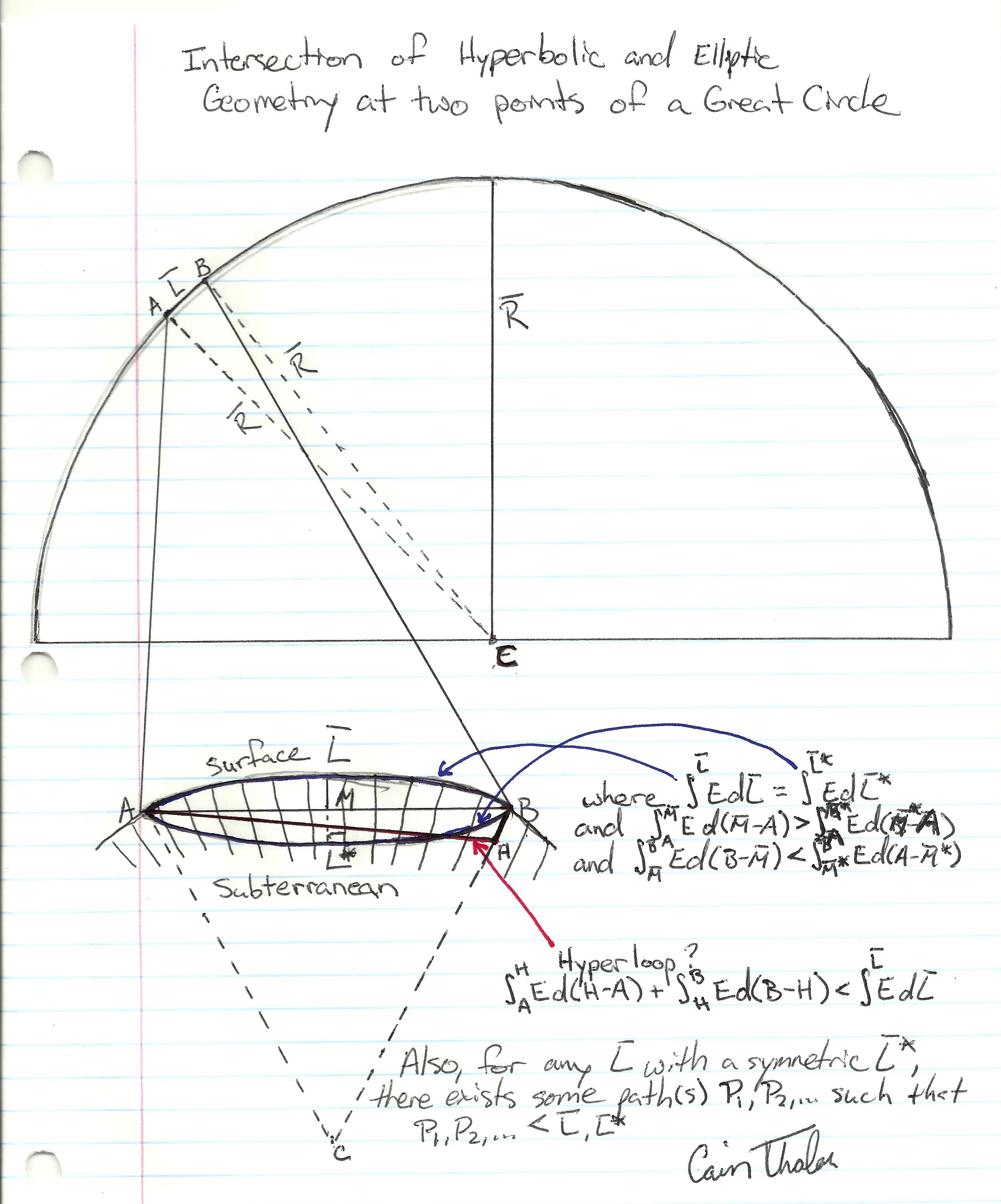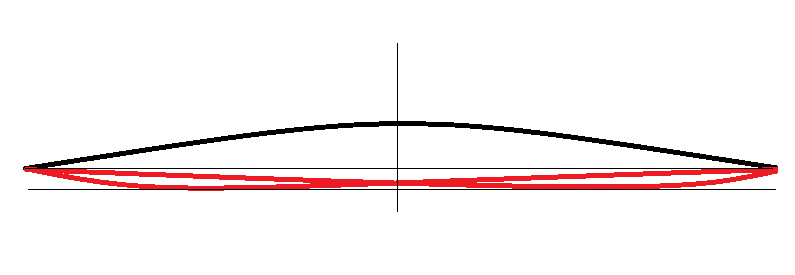It’s the weekend, and before I take off, I decided to spend an hour taking a stab at Elon’s immortality amongst the faithful.
He’s set to announce his superbly hyped, probably unrealistic hyperloop design next month. I intend to release his idea first, for the purpose of killing a god.
My suspicion is that people chiming in so far aren’t even on in the right parking lot. Musk is the guy who built a spaceship company and is currently trying to blanket the US in state of the art charging stations in under two years.
Reality isn’t exactly a factor here.
My guess is that he’s going to propose taking advantage of inefficiencies in geodesics to construct a path that’s shorter than the “shortest” Great Circle path over the Earth’s surface, while setting it up in a way that reduces energy consumption along the way.
A.k.a. bury a big damn tunnel that loops radially towards the Earth’s core.
Something like this:
The shortest integral path along a geodesic surface is along the path of a Great Circle – that’s one of the key findings of Riemann. However, the shortest path between two points, at least in Euclidean space (of which the Earth’s relative size is still small enough to talk about multivariate calculus) remains a “straight line” in the Euclidean sense.
Since the Earth’s a sphere, there exist lots of paths through the surface which are shorter than simply walking along the circle perimeter. This is sort of complimentary thinking of how airplane flight paths are calculated.
If you choose a path that offsets with its lowest point not in the middle of the distribution, then you could potentially construct a tunnel that rolls “downhill” most of the way and takes less distance to travel than any possible path over the surface by a bus or a plane. You don’t need to travel 800 miles per hour, or whatever the estimates are, because you’re utilizing geometry to shorten the distance – basically you’re just moving smart, rather than fast.
If you construct two similar paths mirroring each other, then you have one directional and one return path, both of which roll downhill most of the way, and only require minimal energy to lift you back to the surface.
Interestingly, this approach only works over very large surface areas, because small regions on a globe approximate flat space. Of course, finding some paths that will actually work will be calculation intensive, because at some point the roll straightens out relative to the core and you stop rolling “downhill”. I’m guessing if this is sort of his idea, then his calculations have found a family of paths that will pull it off.
Since any curved path with one leg shorter than another resembles a saddle point, it evokes imagery of hyperbolic geometry…hence, Hyperloop.
Just a guess here. Naturally if I’m right, I demand full credit for early publication (no I’m not that stupid it will never happen).
I like my odds though, because this approach is:
1) Imaginative
2) Physics intensive/clever
3) Totally unrealistic
Hence, it just sort of screams “Classic Musk”.
If you enjoy the content at iBankCoin, please follow us on Twitter







This is the first explanation I’ve seen that I could actually believe he might announce. When the others first started spouting off 750 mph possible maglev things at the same time knowing solar would be powering it, I thought they were nuts. Plus I doubt he would be building all this suspense for something that was already proposed and looked at by other scientists in the past. Your explanation definitely fits better with his ego and him open sourcing the idea.
whoa..
😉
Cain, I majored in Physics as an undergrad, thanks for bringing back fond memories 😀
This post is boss on many levels.
All that work, but you ignored what Musk has actually stated about hyperloop.
For example, contrary to your “basically you’re just moving smart, rather than fast”, he’s stated that: “it goes an average speed of twice what an aircraft would do”.
And, although you recognize that your “approach only works over very large surface areas, because small regions on a globe approximate flat space”, Musk has talked specifically about a SF-to-LA route, which would qualify as a small region.
And there are at least two big problems with your concept of “two similar paths mirroring each other, then you have one directional and one return path, both of which roll downhill most of the way, and only require minimal energy to lift you back to the surface”:
1) There’s no energy benefit from placing the low point (in terms of gravitational potential energy) past the midpoint of the route. The gravitational potential energy of the starting and end point aren’t affected by the route you choose. Going with something other than the straight line route in your figure just means that the overall path is longer – requiring more travel time and more energy.
2) Creating a different route for each direction will nearly double the construction cost.
We know you aren’t a fan of Musk, and the odds are in favor of the Hyperloop idea having some fatal flaws making it unrealistic, but that’s no excuse for making crap up and ignoring what Musk has told us about his idea.
this reply is boss-on-many-levels in retort to MrCT’s boss-on-many-levels post
I have also heard rumblings of the Musk getting into gigantic deep geothermal power plants where the endless-renewable heat energy is tapped deep in the interior of the planet. All the energy requirements on the planet could be met with no dangerous byproducts, waste products, radiation, etc. Therefore no worst-possible-case-scenarios could occur as with Chernobyl, Fukishima, and all future disasters sure to come.
“1) There’s no energy benefit from placing the low point (in terms of gravitational potential energy) past the midpoint of the route. The gravitational potential energy of the starting and end point aren’t affected by the route you choose. Going with something other than the straight line route in your figure just means that the overall path is longer – requiring more travel time and more energy.”
Which is why roman’s constructed their aqueducts on the level – didn’t want to waste that precious energy pumping it at the end.
It’s true you’re using more energy. But keeping the lowest potential difference after the midpoint gives you advantageous control over when and how you service those energy requirements.
Specifically, we currently service the “least energy route” by sticking 600 lb block engines in automobiles, then having them fire constantly along the radial path. Airplanes and trains all have much larger, heavier engines that need to fire.
None of those engines is very efficient. About 20%, I believe.
By having a path that accelerates for the majority of the length, you don’t need to service energy midway – you strip the motor out of your carriage and fire it off at the beginning of the track with a farm more efficient accelerating mechanism. It picks up speed the entire length of the path, which requires only minimal energy requirements for safety equipment and sensors. Then, at the end, you have an elevator that lifts the carriage the few miles to the surface – which you hook up directly to a power plant pushing 40% efficiency and all.
You aren’t violating the second law of thermodynamics. You’re just playing to your strengths.
“2) Creating a different route for each direction will nearly double the construction cost.”
When has Musk cared about cost?
The other points I’m guessing are going to end up being physics riddles. For instance, ““it goes an average speed of twice what an aircraft would do”. What is “speed”? If an aircraft starts at your position and flies around the Earth to five feet behind you, and then you turn around and walk that distance, have you just traveled 25,000 miles in under a minute?
If you follow your projection on the Earth’s surface, you would be traveling faster than your actual, non-geodesic displacement. If you start traveling the speed of an aircraft and pick up speed the whole way, your projection along the surface path would easily be much noticeably faster. I don’t have time to get out the exact math right now, but you could figure it out.
And when are you “in” San Francisco? San Francisco exists as polar coordinates – you’re assuming a path along the surface.
If you end up 2 miles below San Francisco, are you then “in” San Francisco? Probably, technically. I’m willing to bet Musk is playing some fun word games here, that will make his audience chuckle and learn something.
“Then, at the end, you have an elevator that lifts the carriage the few miles to the surface”
Do you even think about what you write?
Several miles of elevator lift? This is your speculation about a high-speed transportation concept?
“When has Musk cared about cost?”
Once again, you are ignoring what Musk has claimed about his concept. He has said it would be cheaper than existing options. You’ve envisioned a mind-bogglingly expensive concept and then found a way to make it even more expensive. Musk might be very wrong about the achievable cost, but it seems unlikely that he has nothing better than “who cares” in response to doubts about the low cost.
But, I’m not going to go through the details of each one of your errors. My next comment will show why I believe that you were so busy trying to be clever that you forgot not to be stupid.
“Then, at the end, you have an elevator that lifts the carriage the few miles to the surface”
It would obviously be slanted, genius, not vertical.
You suggest 2 major benefits of your concept:
1) shorter route vs. travel along the circumference (surface) of the earth
2) a route that is downhill most of the way for energy savings
I’m ignoring #2, partly because your errors take too long to explain and address, but mostly because, as you’ll see below, there are larger problems that make the energy issues irrelevant.
Considering #1, the first question I had was how much distance you could cut from a route by traveling through the Earth.
I looked at a trip from Boston to San Francisco, one of the longest major routes across the 48 states. As the crow flies, it’s about 2690 miles.
By taking the shortest distance through the Earth between the two cities, I calculate that you will cut less than 100 miles off the distance.
2600 miles of deep tunnel for a tiny distance savings. Not so smart.
But it gets worse. If you calculate how deep below the surface you have to go to follow that shortest route, it is in the area of 200 miles. Even deeper if you think that Cain Thaler is right about his “downhill most of the way” routing.
The deepest hole ever drilled by humans is less than 8 miles below the surface. The crust of the Earth is generally just 20-30 miles thick on the continents. 200 miles deep is…not so smart.
Then there is the geothermal gradient – temperatures increase with depth below the surface. At the boundary between the crust and the mantle, estimated typical temperatures range up to 750 F range. The C.T. tunnel goes at least 170 miles below the crust. I didn’t find estimated temperatures at 200 miles of depth in a quick search, but several sources led me to believe that it is hot enough to melt many common minerals (though the pressure at that depth would keep them from entering the liquid state until well above the melt temperature at atmospheric pressure. Tunnels heated to the temperature of lava? Not so smart.
Thanks for pointing out the obvious, Ottnott. Maybe you should explain how tunneling to China would require me going through the core next. I think I was a wee dim on that point…
Hilarious debate. You’re both idiots.
Hahahaha